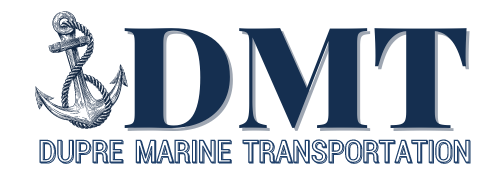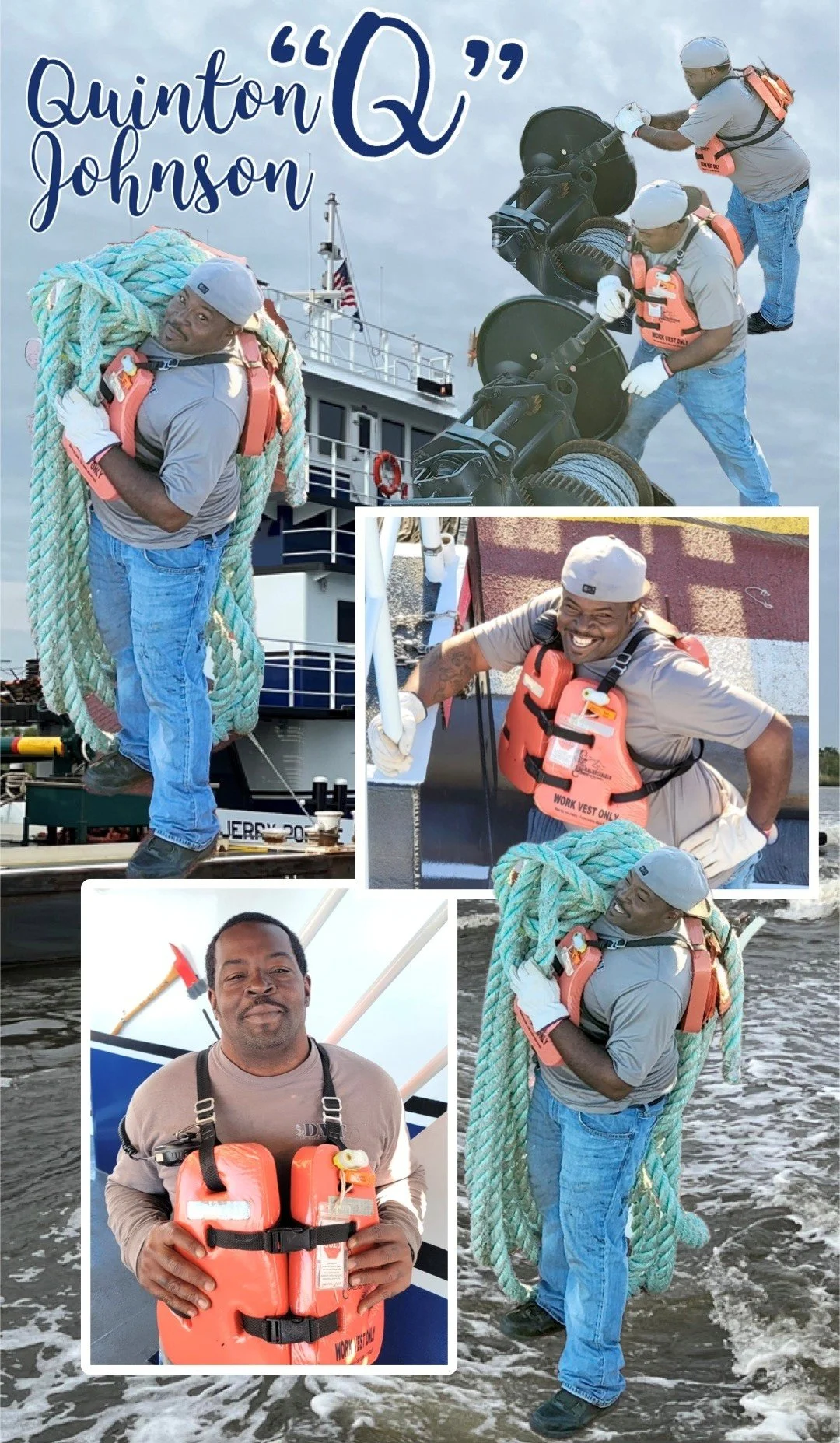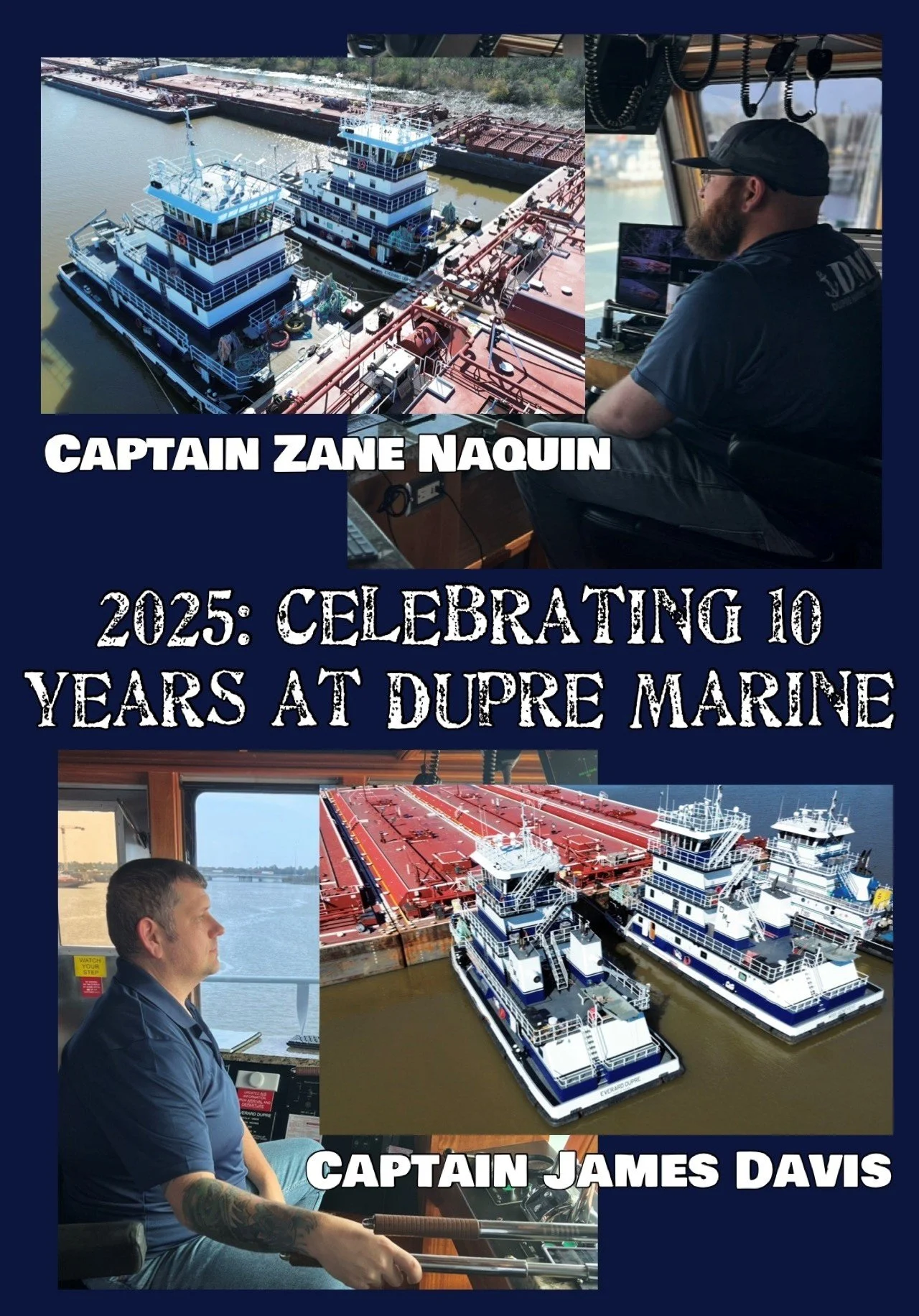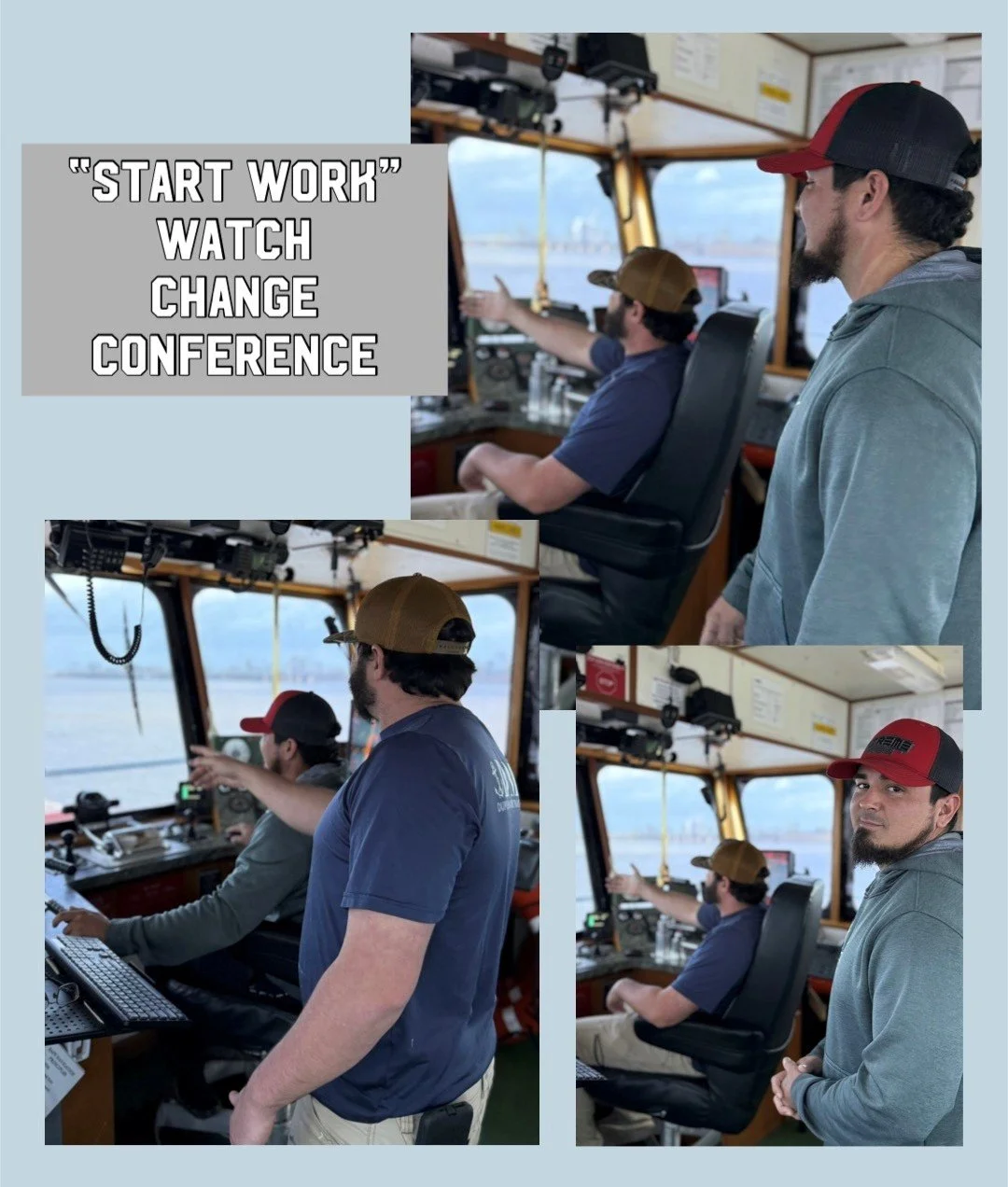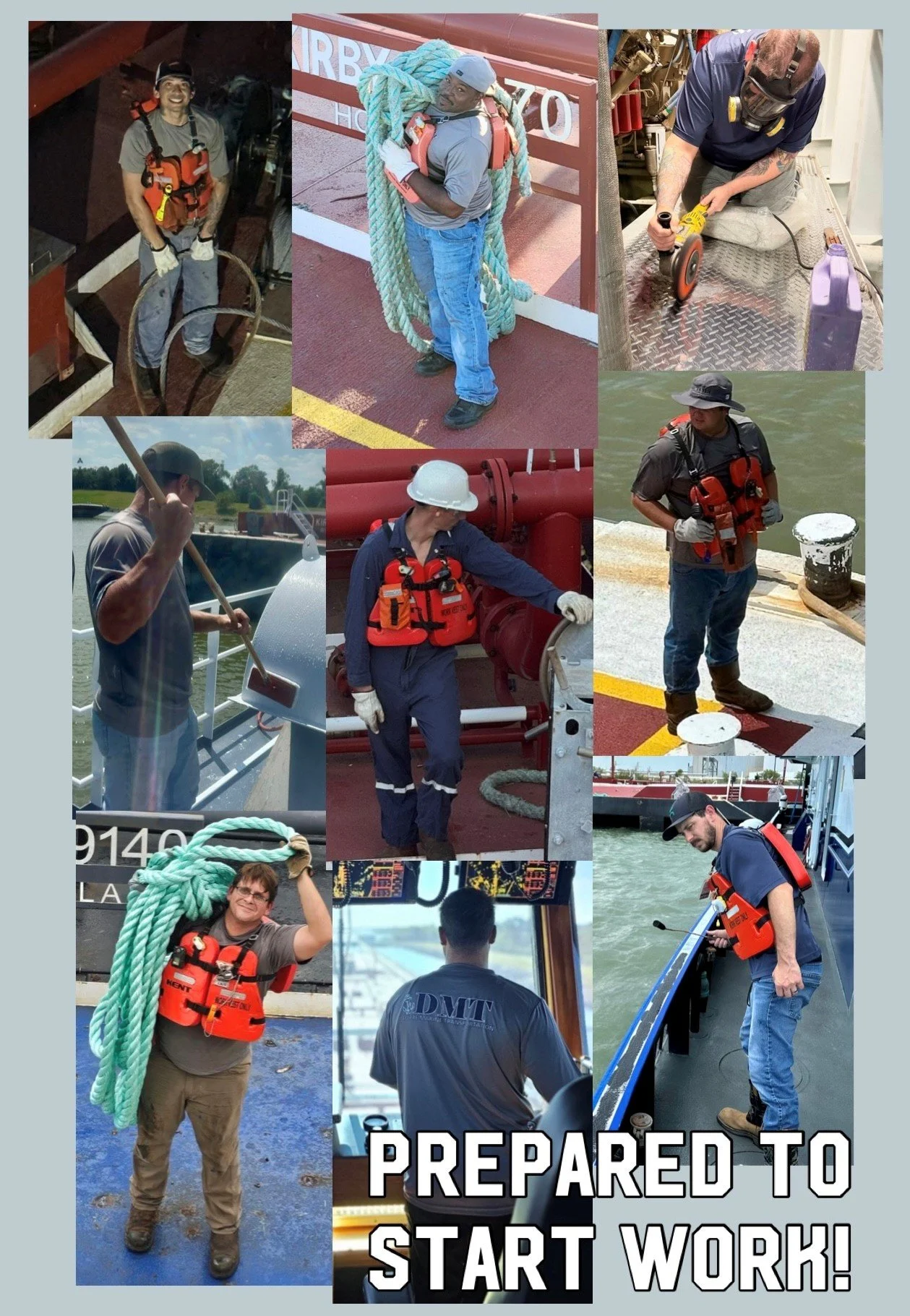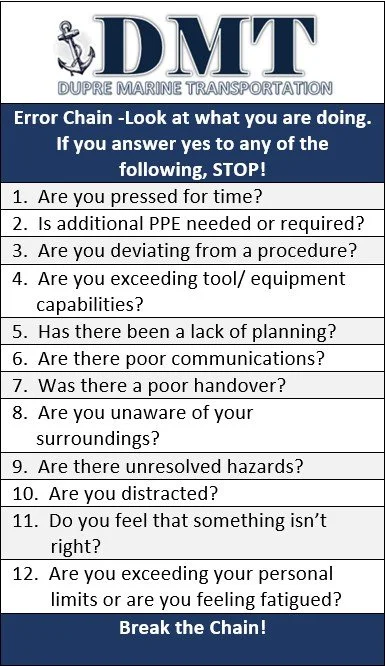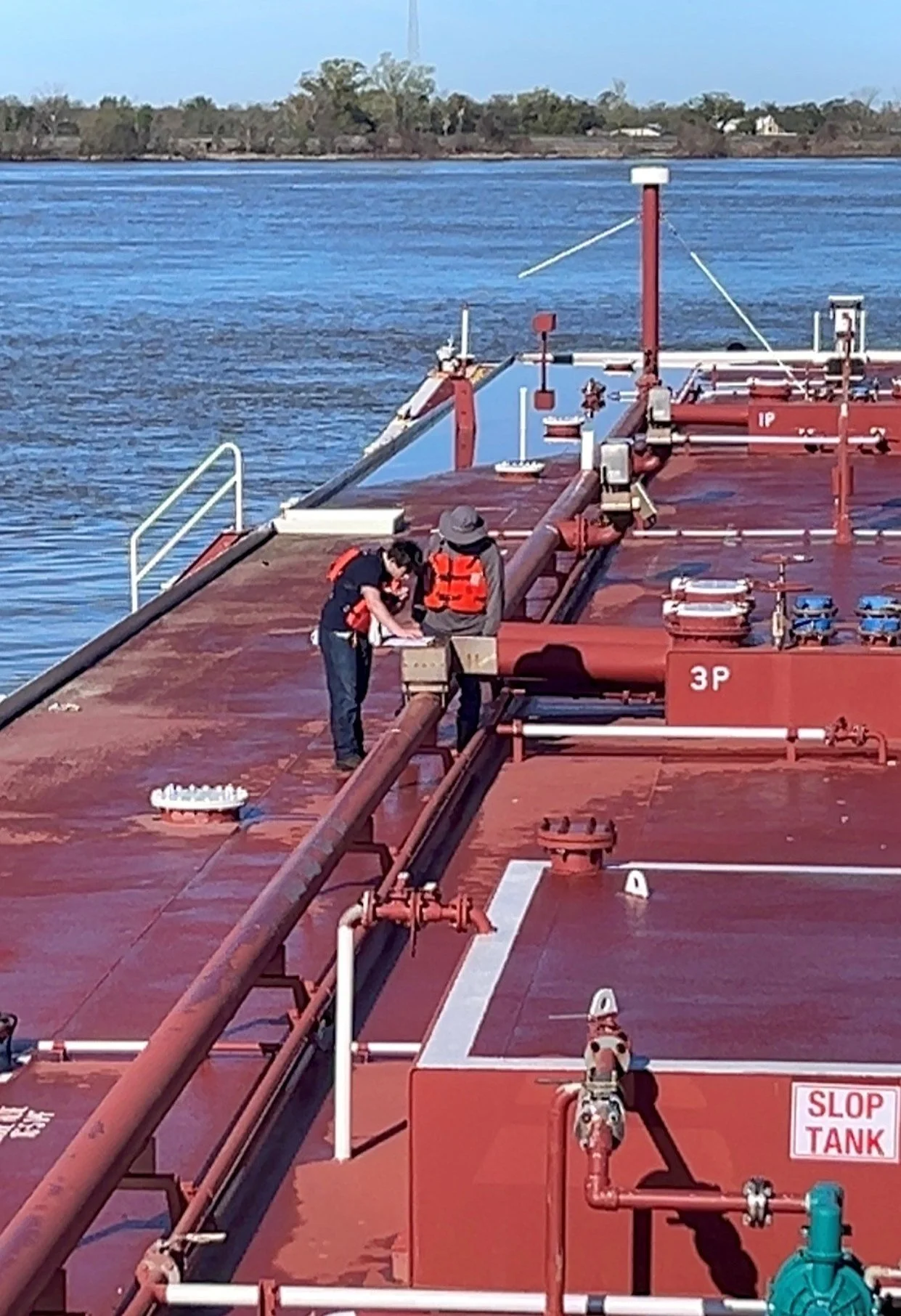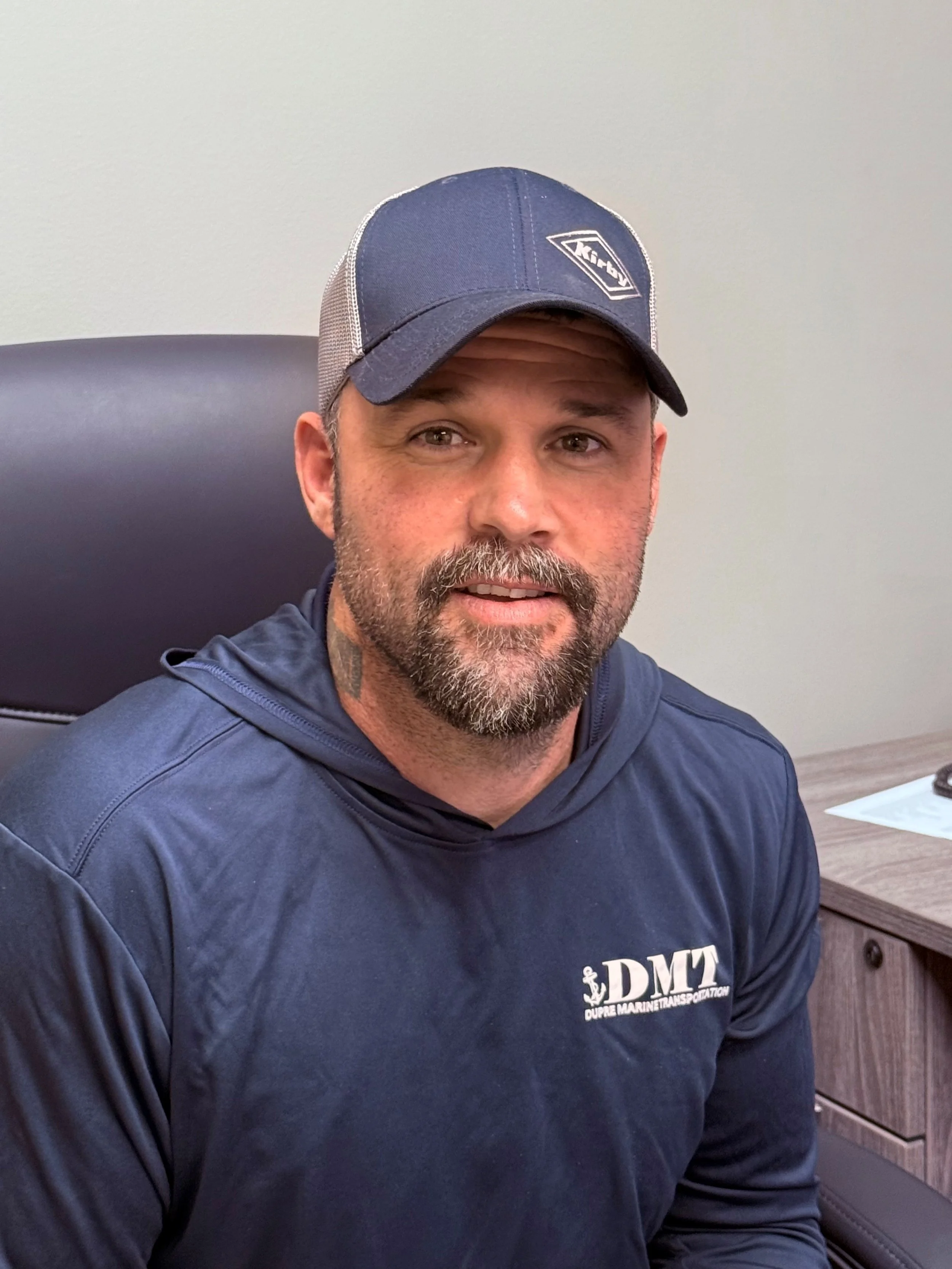| 2025 | Quarter 1 | Issue Fifteen |
the voyager Newsletter
Welcome to Dupre Marine’s Quarterly Newsletter!
IN THIS ISSUE
Employee Spotlights
10 Year Anniversaries for 2025
Just for Fun Quiz
Safety Topic
Crew Safety Quiz
#Deckhandlife
DMT Anniversaries for this Quarter
Company News & Updates
dmt’s Wheelhouse spotlight:
zane naquin
Captain Zane Naquin has spent a decade at Dupre Marine, and is now one of the most respected captains on the water. Great respect from everyone at Dupre Marine, especially his crew. Zane’s exceptional skills and expertise are highlighted by his relentless commitment to safety and effective leadership. With Captain Zane, the M/V MISS GENEVIEVE not only maintains peak performance, but also represents the standard of excellence that he inspires in his crew. Keeping a consistently beautiful boat, his primary goal is to be recognized as the best; therefore, he consistently gets out there alongside his crew to actively get the job done to achieve their goals.
Zane has a very close-knit crew family, which includes his nephew Seth Helmer, who is his Relief Captain. He has diligently trained both Seth and Saige Robinson to effectively work alongside him in the wheelhouse, making sure they all share the same goal of excellence and high standards operating and navigating the boat. With Zane as the Captain, this crew family functions seamlessly as a team that balances their hard work with time for fun too! He shares his humor and boat leadership with us on Shoreside too. We always enjoy when he comes in to see us, talking it up with everyone in the galley for a visit.
Zane shows how he successfully manages the balance between a demanding towboat career and family life. Outside boat life, Zane treasures his family life. His wife, Nina, and their kids, Rorie and Zander, are his main priority and his best buddies. From trips to playing outdoors, he is Dad and husband first. When he visits us in the office, his eyes light up when he talks about his family! He does it all for them!
It is an honor to celebrate the incredible commitment of Captain Zane Naquin. His leadership adds to the strength and success of Dupre Marine. Thank you, Captain Zane, for your loyalty and hard work over the past decade. We look forward to many more years together as part of the Dupre Marine Family!
DMT SPOTLIGHT:
Quinton Johnson
Quinton “Q” Johnson is an truly exceptional crew member at Dupre Marine Transportation for 4 years now. One of the hardest working men in the fleet, he has become an indispensable and essential part of the M/V JERRY PORCHE crew. Q has a great attitude and strong commitment to his work. His drive for excellence motivates others to reach their goals and improve their performance, benefiting both himself and the whole crew.
Not only is Quinton widely known for his tireless hard work and unstoppable commitment, but his humor lightens the atmosphere on board and makes each watch more fun. We can only imagine the laughs between Q and Josh “Tater” Petroff on that boat. Crew Facts! Q is a fan of snacks, he especially is fond of a variety of tasty chips, he is Mr. Salty and Crunchy!
Outside of work on the boat, he resides in Marrero with his loving wife, Nicole and values every moment of family time. Whether it's hanging out together, watching movies, or simply enjoying life and each other’s company, family truly means everything to him, especially his kids and grandkids. They are the reason he works so hard!
We are proud to have Q as a valued member of the Dupre Marine family. His contributions are significant, and his positive spirit is appreciated by all and we look forward to his long career with us at Dupre Marine!
10 years at DUPRE MARINE!
JAMES “TUB'“ DAVIS AND ZANE NAQUIN
WOW 10 Years! 2 more added to the Decade Club at Dupre Marine!
Captain Zane Naquin - February 2015
Captain of the M/V MISS GENEVIEVE
Captain James “Tub” Davis - September 2015
Captain of the M/V EVERARD DUPRE
It is an honor for Dupre Marine Transportation to celebrate the incredible commitment of Captain Zane Naquin and Captain James Davis, who have expertly navigated our vessels for the past 10 years. Not only have they provided their superb boat skills, but both of these captains run an amazing vessel and crew. Their dedication to their craft has played a pivotal role in ensuring the safety of their crews and vessels, showcasing professionalism and skills throughout the years. In addition to their loyalty to Rory and Dupre Marine, each of these captains has unique leadership qualities that adds to the strength and success of our company. They are both determined and succeed at being the best!
Thank you, Captain Zane and Captain Tub, for your loyalty and hard work over the past decade. We look forward to many more years together as part of the Dupre Marine Family!
Welcome claire catherine!
Welcome to our newest Shoreside “employee,” Claire Catherine Ortego, who made her grand entrance into the world on February 12th. Megan, Michael, and Parker are absolutely thrilled and over the moon about the arrival of their precious baby girl!
A Slideshow of Our Favorite Scenic Views from Our CREWS this Quarter:
Fun Quiz: Marine life !
No Googling! Just test your knowledge and learn a little!
Survey for Dupre Marine Employees: Newsletter feedback
We ask all employees to take a few minutes to participate in this optional survey about our Newsletter. Your feedback is appreciated!
We talk about Stop Work all the time, but now we are introducing “Start Work”: start work, start a hitch, start a watch, start a task, start your job. 2025 is the year to focus on START WORK.
Ask yourself, “Am I Start Work ready?” This question is crucial as we prepare to embark on any activity. Being Start Work ready encompasses several elements, including completing all risk assessment procedures, conducting thorough voyage assessments, ensuring a seamless watch change, engaging in meaningful pre-task huddles, applying the Think 72 principle, and confirming that you are watch ready.
By focusing on these key components, we strengthen our commitment to safety and operational excellence. Let us prioritize being prepared each time we initiate a new task, ensuring that we uphold the highest standards in our work environment.
Captain Alex Landry doing watch change with DJ Norris on the M/V COVE POINT
START WORK: WATCH CHANGE
Being ready for watch is essential for safe operations. Each crew member finishing their watch must ensure the incoming crewmember is rested and prepared. If there are doubts about the readiness of the incoming crewmember, the watch change should be postponed, or the voyage may need to pause for wheelhouse personnel changes. All crew members should attend the watch change meeting if possible. If a crew member cannot attend, they should be informed about the discussion topics and key details as soon as possible.
At a minimum the following should be discussed in the Watch Change Conference:
The current Voyage Plan includes changes based on expected operating conditions or hazards found during the trip. This includes orders and risk assessments.
Current and future environmental factors and their impacts on towing include: river stage, tide level, current velocity and direction, weather (check apps), visibility.
Vessel direction, speed and engine speed
Navigation hazards expected during the watch have been identified, and risk management strategies are in place. Examples of hazards include: Locks, bridges, docks, high hazard areas, ship channel crossings
Check and confirm the condition of navigation safety gear, alarms, and mechanical systems.
Discuss the need or requirement for an assist boat.
Check that all watertight and weathertight openings are secured.
Check that the radio equipment works, monitor Channel 16 (or the correct VTS frequency), and note any distress traffic from the last shift.
Any prior watch arrangements with marine traffic in the area and important info from navigation broadcasts
Any watch-ready concerns
Deck crew discussions should include (but not limited to) status of ongoing jobs (scope of work, tools, PPE) and condition of the tow (couplings and rigging, navigation lights, condition of barges and safety concerns such as notches and tripping hazards.
START WORK: RISK ASSESSMENTS
A risk assessment should be done before starting any task. Everyone involved must participate in this assessment and the safety steps taken. If someone joins after the assessment is finished, it must be repeated, and safety measures reviewed before they start working.
Before starting tasks, employees must do a Risk Assessment to ensure everyone understands the job, potential hazards, the people involved, and how to manage risks. There are various ways to carry out these Risk Assessments, including:
PRE-TASK HUDDLE
JSA
VOYAGE RISK ASSESSMENT
HIGH RIVER RISK ASSESSMENT
Risk Assessment Steps:
Identify the risk through: input from crew members, industry sources, safety meetings and drills, audit findings and other methods deemed important.
Asses the initial risk from: input from crew members regarding the identified risk, tools provided, considering all negative outcomes and scenarios, and determining the highest level of consequence to people/environment/equipment (NO HARM IS THE GOAL).
Develop risk controls by: elimination, substitution of less hazardous materials, operations or equipment, warnings, additional PPE, lookouts, additional personnel and other identified ways to control risk.
Reevaluate the remaining risk.
Add more controls if needed.
START WORK: THINK 72
We often discuss Think 72 during the hot months because there is that time of acclimating from home to working on the boat, which takes that 72 hours to prepare yourself then take 72 hours after you are on the boat to get use to the change of the added extended periods of heat. However Think 72 should relate to any time of year of preparing to START WORK!
Preparing at home for your hitch including:
Upcoming weather so you are prepared with clothing and any other weather related items you will need for your hitch.
Appropriate sleep, not going out late the night before crew change.
Crew change location and who you will be driving with or driving alone to be ready for travel to and from the boat. Are there stops to make?
Having all your credentials (TWIC card, MMC, medical card and all appropriate credentials for your job).
Have your PPE bag with all appropriate PPE needed to bring to the boat including work boots. If your boots are worn, new ones should be purchased before you head out for crew change.
Have your personal items packed! Do not forget any prescriptions or personal needs you like for your hitch. (We try to get all packages to the boat for next crew change, but is not always possible with boat location and orders).
START WORK: VOYAGE PLANNING
Voyage refers to the planned transit of a vessel from a specific starting point to a designated ending point.
This includes all travel with barges or light boat voyages. This process requires careful planning and teamwork to make sure the trip is safe and efficient. Some of the key factors to consider during the voyage include weather conditions, navigational routes (any and all stops), locks and bridges, any waterway closures or safety zones, cargo loading and unloading schedules, as well as compliance with maritime regulations. Proper execution of the voyage plan is essential for a successful voyage.
All voyage plans must be entered in Helm.
The current voyage plan must be reviewed at each change of watch by the wheelman coming on watch. Updates to the current voyage plan shall include changes identified in expected operating conditions or hazards identified during the voyage.
START WORK: VOYAGE RISK ASSESSMENT
Voyage Risk Assessments are important for assessing risks when planning a trip. They aim to identify possible dangers and help in setting up safety measures before departure. These assessments are part of the Voyage Plan and are required whenever a plan is needed. All safety measures must be confirmed before any work starts.
START WORK: WATCH READY
Being watch ready is to be rested, alert and situationally aware!
We understand that being watch ready means more than simply being physically ready. It also means being mentally focused, having a clear understanding of the task at hand, and understanding the potential outcomes of any situation that may arise.
By doing so, we ensure that everyone is aware of their responsibilities and is committed to carrying them out effectively. The start of every watch is a great opportunity for any crew member to ask questions or raise concerns, which can ultimately help prevent potential issues from happening.
Take your job seriously and understand the importance of being watch ready at all times!
What does it mean to be RESTED?
You’ve had appropriate sleep during your time off-watch
You’ve had a chance to refresh/regain your strength after strenuous work
You’ve eaten healthy meals and stay hydrated
You do not feel overly tired
What does it mean to be ALERT?
You are active, attentive and observant
You are quick to notice any unusual, potentially dangerous or difficult circumstances
You are focused on the task at hand
You are engaged in conversation, communication and problem solving
What does it mean to be SITUATIONALLY AWARE?
You are in-tune with your surrounding environment and potential factors that may impact you, your crew or your equipment
Weather
Tides
Water flow
Other equipment
Attention to your crew and their attentiveness
Continually assessing and re-assessing your environment
PPE ✅ WATCH READY ✅THINK 72✅PRE-TASK HUDDLE ✅
START WORK: PRE-TASK HUDDLES
Pre-Task Huddles
Pre-Task Huddles are straightforward and efficient last-minute risk assessments that should be conducted prior to any task, regardless of the number of individuals involved. These assessments do not require any paperwork, making them easily accessible for all team members.
When to Conduct a Pre-Task Huddle
Examples of scenarios where Pre-Task Huddles should be implemented include, but are not limited to:
The usage of power tools
The usage of pneumatic tools
Painting activities
Servicing engines
Getting underway
Barge mooring
Conducting a Pre-Task Huddle helps to ensure that everyone is aware of potential risks and that safety measures are clearly communicated.
The ERROR CHAIN should be used to outline Pre-Task Huddles using the following guidelines:
START WORK: HIGH RIVER RISK ASSESSMENT:
HRRAs help identify risks when people, equipment, and the environment are at higher risk due to high river conditions.
They are needed when vessels operate in the Mississippi River and the Baton Rouge Gauge is at or above 25 feet, or when DMT management decides it's necessary in certain situations, such as:
Shifting barges in the river.
Acting as an assist boat or needing help from another boat.
Entering or exiting the river.
The DMT-F024 High River Risk Assessment form must be filled out. If a customer risk assessment is needed during high river conditions, a DMT HRRA is not required. All safety measures must be in place before starting work.
START WORK: JSA (JOB SAFETY ANALYSIS)
A Job Safety Analysis (JSA) is essential for starting a job safely. These documents are usually prewritten and available to the fleet through Helm CONNECT. After a JSA is completed, key details like topic, time, and location are recorded in the Master Log. This helps identify hazards and establish safety measures, making the workplace safer. All crew members must understand the JSA related to their tasks to ensure accountability and safety compliance. Regular reviews and updates of the JSA are vital to reflect any changes in procedures or environmental conditions.
Examples of when to do a JSA include but are not limited to:
Cargo Transfers (Loading & Discharging)
Cargo Hose Connection/Disconnection
Transiting Locks
Tow Work
Boat Fueling
Barge Fueling
Docking / Fleeting
Skiff Operations
Crane Operations
Diver in the Water
Narrow bridge, Channel, or Structure
Low Overhead Clearance
Limited Visibility
Ship Channel Crossings
Congested Areas
Downstream Landing
Barge Pickup
*NOTE: Sometimes, the Wheelman on watch may feel it is necessary to do another Job Safety Analysis (JSA) before starting a new task other than listed above. This choice is important for finding and managing any risks to keep everyone safe. The Wheelman's careful approach helps improve safety measures and highlights the need for careful risk assessments in every job.
START WORK: OBSERVING ALL OTHER RISKS BEFOREHAND
New and Non-Routine Tasks are infrequent tasks outside regular work that require special attention.
These must be reported to the Port Captain right away, as they need a Qualitative Risk Assessment, Management of Change, Special JSA, or a combination of these. The Port Captain will coordinate with necessary shoreside personnel to ensure a thorough risk assessment and obtain approval from the Vice President, Operations Manager, and/or President before proceeding.
The risk assessment should include:
A description of the tasks.
Any alternative methods to complete the task.
Identification of all affected individuals.
Recognition of hazards.
Identify mitigation measures and controls.
Identify residual risks.
Identify additional mitigation measures if needed.
Once the risk assessment is done with input from those involved, shoreside management must discuss the risks and mitigation measures with everyone affected. After applying mitigation measures, the risk assessment must be sent to the Vice President, Operations Manager, and/or President for approval before starting the task. Approval depends on completing the mitigation measures. If a non-routine task occurs again, the previous risk assessment should be reviewed with all involved parties.
SAFETY QUIZ:
FOR ALL VESSEL EMPLOYEES
ALL crew members must answer these questions. This quiz will review the main safety topic for this Quarter. When you are complete and hit “Submit Answers” you will get a response with your the answers and learning information. This will be a part of your safety compliance.
#DECKHANDLIFE: barge inspections
Johna Chaisson and Kollin Parfait doing a barge inspection on the M/V ISAAC K
BARGE INSPECTION #101:
Barge inspections are crucial for spotting hazards, ensuring good customer service, and detecting damage. They should be done carefully, and all issues must be reported to the Wheelman on Watch right away. If a barge inspection is not done correctly, it can lead to blame for your vessel and crew for any missed damage and could cost Dupre Marine tens of thousand of dollars in repairs for damage we did not do. This is a costly error!
This is not just for deck crew, but also good reminders for the wheelmen and a good subject to review as a crew.
WHAT TO LOOK FOR IN A BARGE INSPECTION:
✅Decks – Check for cracks, dents, or holes. Ensure there are no obstructions or hazards that could cause slips, trips, or falls, such as broken rigging, old lines, or too much cargo.
✅Corners -Check for cracks, dents, holes, or anything that may weaken the barge.
✅Cargo Box – Cargo boxes often have small dents from loading and unloading, so use your judgment when checking them. Look for significant dents, any cracks, or holes, and note these on the Barge Pick-Up Inspection Report.
✅Clean – Clean empty barges of any leftover product. Ensure that no excess product remains in the cargo box.
✅Coaming – Check the coaming for dents, cracks, or rust.
✅Wing Tanks – DO NOT ENTER WING TANKS FOR INSPECTION! Check for water and if excessive water is found, pump the tank. If a leak is found and entry is necessary, refer to the Dupre Marine Transportation Confined Space Entry Procedure.
✅Sides - Check for cracks, dents, holes, or anything else that could weaken the barge.
✅Deck fittings –All deck fittings must be checked for cracks, excessive wear, or any issues that could weaken them. Fittings for rigging should be inspected twice: once when picked up and again before rigging is applied.
✅Trash on Deck –Ensure the barge decks are clear of trash, including kitchen waste, old wires, and trash lines, etc.
✅Barge Covers – Inspect fiberglass covers for cracks and holes, ensuring all access doors are secure. For steel covers, check for dents, holes, and rust.
✅Manhole Covers – Ensure they are secure and properly dogged down, and check for rubber seals too.
✅Environmental Factors- Check for any sheens. If a sheen is found, the crew must inform the Wheelman on Watch right away and look into the source of the sheen.
WHEN DO YOU DO A BARGE INSPECTION:
When a barge is picked up, the Tankerman or deckhand must get the barge's six-digit code from the mailbox on board. They should confirm the code with the wheelman on watch before starting the inspection.
When a barge is left unattended by its crew, there are concerns about quick trips to assist other boats. Upon returning, the barge must be inspected. Any unsupervised barge by our crew for any amount of time must be inspected.
At a minimum of once in a 24 hour period.
Before dropping off the barge. Make sure the next boat picking up this barge doesn’t catch your miss.
Whenever there is a concern that the barge(s) might be damaged.
Prior to a load or discharge. When receiving orders for a cargo transfer or moving to the dock, an inspection must be done before departure or within 12 hours if already moving.
After a load or discharge.At the end of the transfer, check that fuel is filled, trash is cleaned, all valves are closed, and there are no drip pans with liquid. A Post-Transfer inspection can satisfy the Pre-Transfer inspection requirements if the next docking is within 12 hours and the barge remains with the same crew without any breaks.
VERIFY THE BARGE NUMBER! This is a costly error if an incorrect barge is picked up.
The deck crew must check the barge's name and number and tell the Wheelman on Watch. Then, the Wheelman must verify the barge’s name and number in the orders and confirm with the deck crew to start the inspection. Kind of like using DART…VERIFY AND REPEAT.
Before leaving the fleet/facility for drops or pickups, a deck crew member should verbally review the barges in the current tow with the Wheelman on Watch.
Barge numbers must be checked during inspections. If a barge is left unattended for any time, the Wheelman and deck crew must confirm the barge number and match it with the orders before leaving.
⚠️
It is the goal of Dupre Marine that all employees work safe hitches and go home to their families after their hitch is completed
DUPRE MARINE’S ANNIVERSARIES for First Quarter 2025
AS OF JANUARY 2025:
Jacobi Guidry: 1 Year
Brendan Beach: 1 Year
Robert Conklin: 4 Years
Lucas Richard: 1 Year
Jason Arceneaux: 3 Years
AS OF FEBRUARY 2025:
Alvin Miller: 3 Years
Bryce Larousse: 4 Years
ZANE NAQUIN: 10 YEARS
Quinton Johnson: 4 Years
Kevin Conklin: 1 Year
Ben Stewart: 2 Years
Lucas Richard: 2 Years
Kevin Douglas: 1 Year
AS OF MARCH 2025:
Cleve Vincent: 5 Years
Patrick Gunter: 3 Years
Eric Spencer: 4 Years
JEREMY CAVALIER: 12 YEARS
Naru Rodrigue Jr: 4 Years
company news & updates
VESSEL NEWS:
M/V DEXTER PORCHE
Just in case you are living in the front hole of your boat, Dupre Marine’s big news is the M/V Alva Dupre is now the M/V DEXTER PORCHE! The Dexter was Christened on February 17th then went straight to work with Matt Gisclair as the Captain. The real Dexter Porche was very proud to have his name on one of our Dupre Marine vessels. And the boat looks beautiful! It was brought down to the steel and refurbished inside and out. The interior of the boat is a stunning transformation! Safe travels to the crew!




shoreside NEWS:
Port Captain Jade O’Neal
We are pleased to introduce our new Port Captain, Jade O’Neal! With a remarkable 20 years of experience working on boats and an impressive 6 years dedicated to Dupre Marine and Captain of the M/V JERRY PORCHE, Jade brings a wealth of knowledge to our team. He is not only an exceptional captain but also possesses outstanding boat handling skills. Jade demonstrates a masterful attention to safety, adherence to procedures, and meticulous attention to detail. His professionalism is evident in every aspect of his work, making him a valuable asset to Dupre Marine. Please welcome Jade to Shoreside as the connection from the vessels to shore, as he works to keep Dupre Marine one of the top towboat companies in the industry.
DMT Company Info:
If you haven’t already, please join or make changes to your Dupre Marine 401 K plan just call Jamie at the office during office hours.
If you have ANY changes to your personal info, marital/child status, banking info, tax status, please let Jamie or Karly know as soon as possible! You can call during office hours or email directly jrobichaux@dupremarine.com or kboudreaux@dupremarine.com. Please also know that any of these changes must come directly from the employee.
We have a NEW PAGE called DMT Crew Page on this website that is just for our Crew Members. Quick links for the Safety Reward, Uniform Shirts/Hats, Online Training and TWIC Renewal. Check it out and save it to your favorites for quick access.
A reminder ALL deckhands and tankermen who work on any vessel in unit tow service must be clean shaven, regardless if our crew members are tanking or shore tankermen are utilized. Any wheelmen with facial hair must be neat and trimmed as specified by Calvin or Jade for the customer requirements. This is a DMT policy as well as our customers’ policy. It is for your safety.
Stop right now and check the expiration dates on all your credentials (MMC, Medical Card, TWIC, Drivers License, etc). Although we track your info in Helm, lately it is not enough time before expiration. With your time on the boat and the time it takes to get the process done, you could expire and not be able to work. It could take a couple months to several months. Please get with Karly if you need any help with your MMC. And here is the link to renew your TWIC card online https://universalenroll.dhs.gov/programs/twic
This is your livelihood, your career, so keep track of it please!
Do you get stuff shipped to the office for crew change? We are more than happy to get your packages to the vessel, but please help us out and text/call/email to let us know when it is coming so we can look out for it.
Complete all your current and due online training. This is a compliance requirement, audit requirement and also tied into your Safety Reward Points that will be distributed near the beginning of each quarter
For those who are new or may not know, this website and our social media pages are filled with photos and videos sent in mostly by our crew members and other towboaters. If you have photos you want to share, please send them to Denise via text, email or dm on our Instagram or Facebook pages. If you haven’t done so, please check out all the amazing contributions on all our socials and this website. And we are on TikTok @dupremarinetowboats for any video contributions!
If any of our crew members would like to contribute content to future newsletters, please email Denise dmorencie@dupremarine.com
Office hours are 0800-1700 Monday to Friday, please note the times you contact shoreside during off hours when it is not urgent. If it can wait until office hours, please call then, and of course if it is urgent call the necessary contact for the problem.
submit NEAR MISses OR STOP WORK RESPONSIBILITY
PUMP UP THOSE NUMBERS!
We always track all Near Miss and Stop Work entries submitted by our crew members, but this year we are focusing on how many near misses are submitted by each boat per month and sending those numbers to the boats.
In 2024 we had the most Near Misses submitted! Captain Robert Woody Stracner submitted the most for the year and as a crew the M/V MISS GENEVIEVE entered the most near misses.
And submitting a Stop Work Responsibility is such an important safety tool.
From Calvin: “Stop Work Responsibility is important because it empowers employees at all levels immediately. It doesn’t matter what your position is, how long you have been employed at the company, or even your overall experience level in the industry. Everyone has the tool, and it is everyone’s responsibility to use it when circumstances dictate. Stop Work removes the red tape and forces everyone to take a look at the hazards.”
pump up those numbers!
〰️
pump up those numbers! 〰️
Remember to submit your Near Misses and Stop Work Responsibilities in Helm regularly. They are not only strong safety learning tools, but also recognized in the charter group and rewarded from Kirby Inland Marine. An important recognition!
On thursday March 27th Alex Landry, Matt Gisclair and Joe Grizzard attended Kirby’s Award Banquet in Houston for their stop works
know the correct PPE for any job!
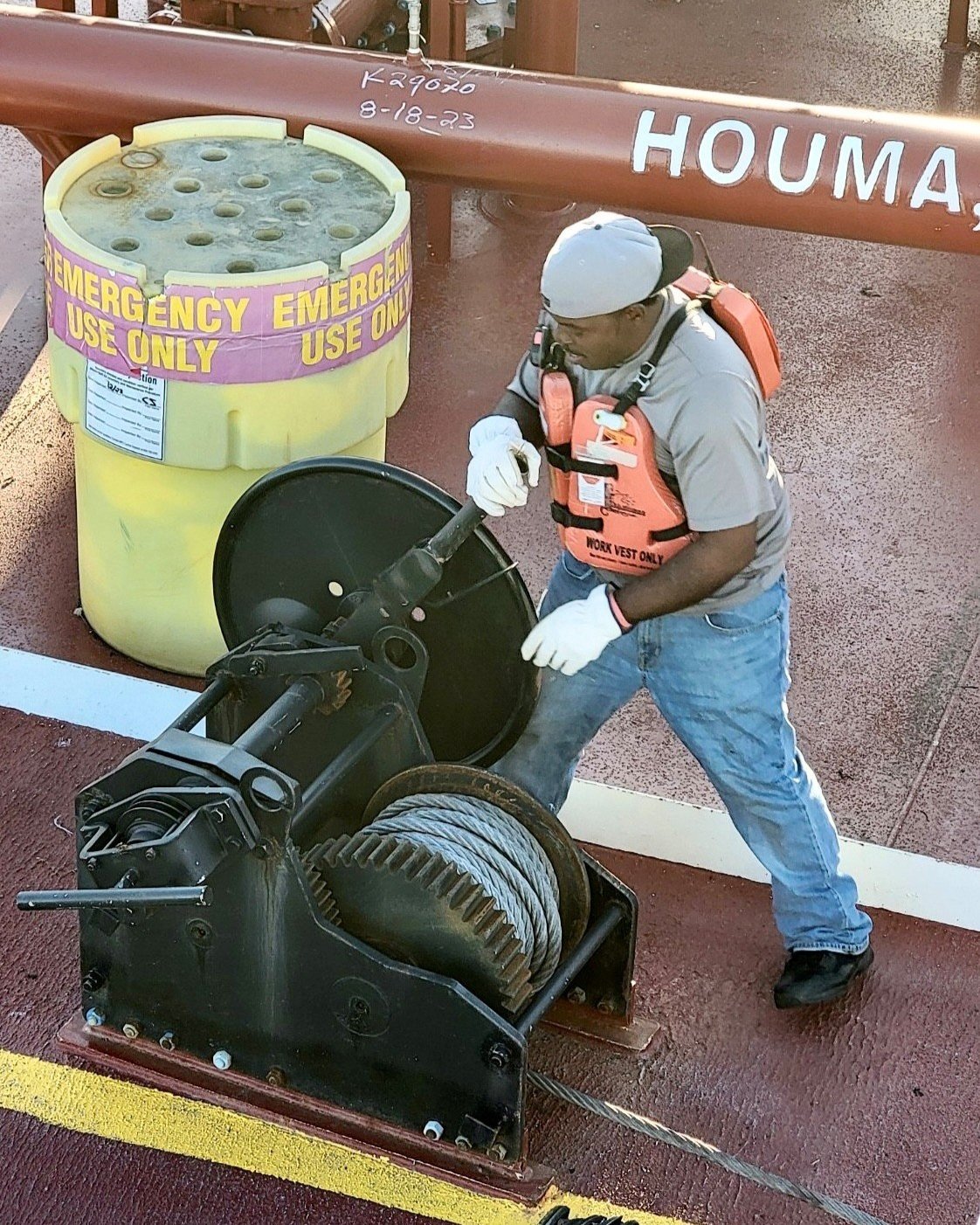



⚠️ If you have any questions concerning your PPE, please contact Port Captain Jade O’Neal
⚠️ If you change positions (for example from deckhand to tankerman) please be make sure you have all required PPE for this job.
⚠️ Always be ready to work wearing the proper PPE and wearing it correctly! Your PPE will NOT protect you if it is not the correct type, is damaged or worn and if is not on correctly and adjusted properly!
⚠️ Be responsible and know what PPE is required to use in your particular work situation Check yourself and ask yourself if you have on what is needed and required to be safe for that job
⚠️ Steel toe boots are required footwear. All Dupre Marine crew members will get $100 towards new boots: all deck crew every 6 months and wheelhouse every year. Please get with Lynsie or Michael when you need to purchase new steel toe boots. We use Joe’s Boots in Houma, which we will payroll deduct the amount over $100 or you may purchase elsewhere (including the safety points site which we will reimburse points) and submit your receipt to Lynsie or Michael for a reimbursement up to $100. We are now tracking purchases. Deck crew this is an important part of your PPE, so please make sure your boots are in good shape always. Captains, please inspect the boots of your crew regularly. If you have any questions, please contact Jade.
Rory’s Favorite Quote to our Dupre Marine Team:
“Gentlemen, we will chase perfection, and we will chase it relentlessly, knowing all the while we can never attain it. But along the way, we shall catch excellence.”
~Vince Lombardi
